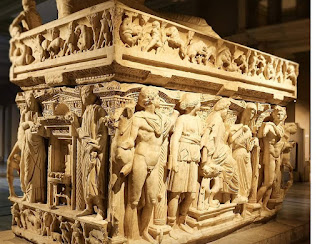Chapter 8, Rise of the Celestial Houses: Cranden, Rax, Darmen, and Naelax
 |
| Darmen merchant caravan, c. -240 CY Art by Merlkir |
The Cranden, in the north, were the most ambitious, desiring to regain their former lands on the western side of the Flanmi in the north of Thalland. Even given that kingdom’s weakened state after its series of wars with the Bladelands and soon to be convulsed by inner turmoil, the Cranden Principality was far too small and weak to perform this feat. The Darmen, in the south, were more concerned with adding to their trade network, which was the most widespread of any of the Aerdi houses. Darmen merchants travelled and traded throughout the Aerdi lands and into the neighboring nations of Ehlissa, the Iron Hills, the Zelrad Principalities, Nehron, the Sunndi lands, and even further beyond, to Urnst and the Flan tribes to the northeast. The Rax, between them, was the weakest principality in the partnership and were notable mainly for balancing the power between their two neighbors, taking the weaker side in any dispute.
 |
| Scene from "The Six Arrows", staged at the Royal Opera House in the City of Greyhawk, 575 CY Washington National Opera |
“Seek some physic of war’s harvest/Whether to know if they did bear/Like true warriors, cold Death’s embrace.”
Upon learning that her favorite son, Ammado had been cut down fleeing the battle, she curses him –
“Would that this worm while in my womb/Had shriveled and been accouched still/Rather than I must bear his shame/Where once I proud his fame did sing.”
As famous but much more consequential to history would be the Massacre of Discordsmight(2) in the last week of Ready'reat of -225 CY. The leading Naelax family in the Medegian lands, the Cinas, had negotiated a marriage between a daughter of theirs and the heir to the Medegian Prince. More importantly to the Medegi, it brought their swords to an alliance to put down a rebellion in eastern Medegia, centered on the coastal town of Montesser which was the center of power of the Aerdi-Suloise house of Montesseri. The Medegi had no reason to be suspicious of large groups of armed and armored Naelax knights pouring into Mentrey with their retinues; first to observe the nuptials on the day after Discordsmight, and then to march on Montesser. The festivities of Discordsmight Eve went long into the night. In their inebriated state, none among the Medegi noted that most of their guests did not imbibe as heartily as they did. So it was that in the small hours of the morning, on signal, the Naelax fell upon their hosts, slaughtering first the Prince and his family, then the cadet branches of the Medegi and their strongest supporters and soldiery. In the following days the massacre spread outward from Mentrey, putting an end to the Medegi, root and branch. The only member of the family who remained alive was the heir, Belfante, who was married to his Naelax bride and allowed to live as a puppet only to the birth of twin sons. Upon their delivery he was dragged from the side of his wife’s birthing bed by her brothers who then stabbed him to death in the hallway outside, his dying cries mingling with the howls of his newborn sons.
The purge of the Medegi and their followers left the Cina’s military power considerably reduced so they were forced to come to terms with the Montesseri, giving that family room to reinforce their position. For their part, the Naelax in the Naelax Principality spurred on their efforts to gain more allies in the former Bladelands, to counter the threat of a Cina-dominated Medegia to their power.
Thalland could have easily taken advantage of this discord had they not been consumed with an internal conflict of their own. The disappearance of Ferrante in -242 CY set off a struggle between the leading noble houses to fill the position of chancellor and other influential posts at court. Other than brief brawls between the various factions the situation did not escalate into civil war, but tensions remained high until it came to a head in -238 CY when the long reign of Alamnos II ended upon his death. Thellari law was clear that the eldest, Bandos would be crowned as king, but he was a weak and ineffectual ruler, cursed with two younger brothers who were both charismatic and assertive. Coupled with the division of the nation’s nobility into various factions supporting one brother or the other, it is no wonder that civil conflict broke out later in that year in what became known as the War of the Three Brothers.
 |
| Ehlissa XIII of Eastern Ehlissa, later Ehlissa XV of the re- United Queendom of Ehlissa Art by Sara Golish |
With the attentions of the strongest nations in the eastern Flanaess occupied either with other conquests or internal strife the stage was set for the foundation of the Kingdom of Aerdy.
Next Chapter -- The Founding of the Kingdom of Aerdy
Art Notes:
End Notes:
1. This is inspired by Aeschylus’s play, The Persians.
2. Once again drawing from real world events, the Massacre of Discordsmight is inspired by the St. Bartholomew’s Day Massacre of 1572, where King Charles IX of France ordered the assassination of prominent Huguenot leaders during the celebration of his sister Margot to Henri de Bourbon, King of Navarre.


Comments
Post a Comment